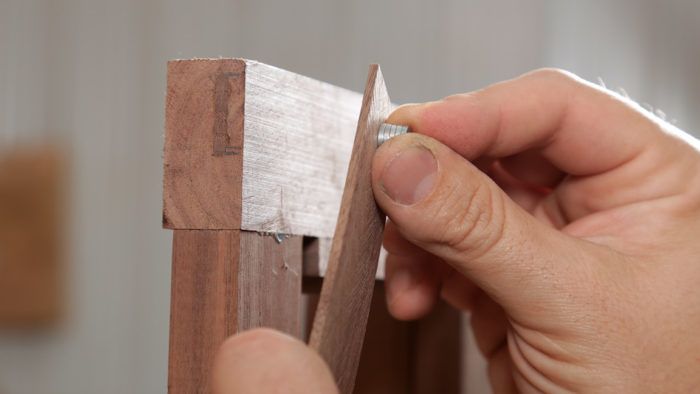A Hidden Magnetic Door Catch
This subtle, magnetic method remains unseen
Synopsis: Concealed rare-earth magnets are an invisible and quiet way to hold cabinet doors closed. Joe Morgan hides a single magnet in a mortise in the door and a stack of smaller ones in the carcase, adding function to his furniture without sacrificing clean lines. Morgan explains how to cut the mortises with a plunge router and how to determine the number of magnets you need.
While there are many types of latches to hold cabinet doors in place, most don’t pull me in. I find protruding mechanisms visually unappealing, and I don’t like the sound of latches hitting each other. So I turn to another method: hidden magnets. Concealed rare-earth magnets provide a pristine look and quiet operation. When done right, the magnets have a subtle grab that makes opening and closing a door a pleasure.
For each door, you need one 3⁄4-in.-dia. and four to six 3⁄8-in.-dia. neodymium disk magnets. Each should be 1⁄8 in. thick. You will also need a plunge router. I use mine with a mortising jig adapted from Michael Fortune’s article “Try this Versatile Mortising Jig” (FWW #198). You could also simply clamp a wide base to the door and attach a fence to your router. Just make sure the router is stable.
Mortising the Doors
After the door is built and trimmed to fit, you’re ready to rout the mortise for the magnet. The mortise should be 1⁄8 in. deeper than the magnet’s diameter so you can glue in a plug to conceal the hole. On the edge of the door, lay out the mortise. Inset the mortise at least 1⁄8 in. from the inside face of the door, and mark the length to ensure wiggle room for the 3⁄4-in.-dia. magnet. With the workpiece secured and the router stable, out the mortise. Place a magnet inside and glue a plug in place.
Magnet Testing
It is important to have the correct amount of magnetic force. Too much, and the door will be hard to open. Too little, and the door might not stay closed. Rare-earth magnets are remarkably strong, but their attraction falls off quickly as they move apart. To test how many magnets the carcase needs, first build the doors, install their magnets, and add their hinges.
For the test, I attach the door to the actual carcase or, if the case isn’t finished, a tall scrap clamped vertically in the vise. Make sure the door is perfectly level and plumb. You will need a short length of 1⁄16-in. veneer and, to start, four or five 3⁄8-in.-dia. magnets. Hold the stack of magnets flush against the veneer and approach the back of the door. Start 2 in. from the hidden magnet and move slowly toward it to test the magnetic attraction. Your goal is to have the magnets engage when they are 3⁄4 in. to 1 in. apart. Add or remove magnets until you land in this range. Whatever number works is how many magnets you should put in the carcase.
More on FineWoodworking.com:
- Shopmade Catches and Latches – Four woodworkers, four solutions
- Keep Your Door Closed – Handmade latches add function and flair to your furniture
- Case Closed – How to use off-the-shelf hardware to close cabinet doors in style
For the full article, download the PDF below.
Fine Woodworking Recommended Products

Osmo Polyx-Oil

Bahco 6-Inch Card Scraper























Comments
Great article and illustrations
Magnetic Force Notes:
Magnetic force is inversely proportional to the distance squared. Doubling the distance reduces the magnetic force by 4X
Stacking magnets doubles the force for each additional magnet added. Well, up to a point. Once the stack height exceeds 1/2 the diameter of magnet the force gain drops rapidly.
Neodymium magnets come in different grades and strengths. Some grade examples of many (N35, N38, N40, N42, N45, N48, N50, N52 ..). Larger the number, greater the magnetic force and cost
Nickel plated magnets protect the magnetic material from corrosion. Corrosion reduces the magnetic force.
Great article. I noticed in the bottom left photo on page 47 that there appears to be a magnet already in place to the left of the stack being installed. What is its purpose?
Sorry for my late reply. This cabinet has two doors, so the stack to the left is for one, and the one Morgan's installing is for the other. Hope this clarifies things!
Why go to all the trouble with mortise jigs? Why not use Forster bits a drill the holes?
Log in or create an account to post a comment.
Sign up Log in